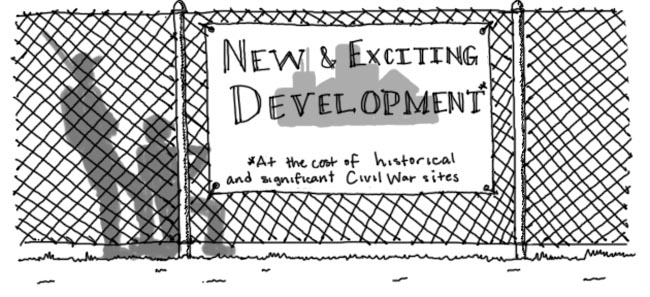Williamsburg thrives on its association with Revolutionary history. Lesser known is its involvement in the Civil War. On May 5, 1862, 72,000 combined Union and Confederate soldiers fought the Battle of Williamsburg, which spanned James City County, York County and Williamsburg, resulting in nearly 3,900 casualties. Currently, only 3 percent of the battlefield is protected; local governments and developers must do more to preserve this battlefield, given its historical significance to both the College of William and Mary and to the Civil War, and its potential for attracting tourists.
For further context, the Battle of Williamsburg brought Confederate troops retreating from the Siege of Yorktown into conflict with the pursuing Union Army. Ultimately, the Confederate army would continue its retreat into Richmond — its intended destination — and the Union army would occupy the Williamsburg area, including the College, for the rest of the war. Three months later, Union soldiers would burn down the Sir Christopher Wren Building, and much of the campus.
In addition, the Battle of Williamsburg was the first major battle for most of its participants; it was their first experience of the brutality of the Civil War. Seven Union soldiers received the Medal of Honor for actions during the battle, and General Winfield Hancock earned his nickname “the Superb” in James City County.
The Battle of Williamsburg also helped change the federal government’s position on whether to liberate slaves. Most white northerners did not want the war to be about slavery, only secession. Runaway slaves, who had been forced to build Confederate forts, provided pivotal information to the Union during the Battle of Williamsburg.
As a result, the federal government realized that slaves were crucial to the Confederate army — and also to the Union army, both for their intimate knowledge and their eagerness to help the Union, shifting the Civil War’s narrative from one of preservation to one of emancipation.
Its historical significance aside, the battlefield would attract tourism. The Civil War Trust, a non-profit organization dedicated to battlefield preservation reported that, in Virginia, Civil War enthusiasts stay twice as long and spend twice as much as regular tourists. The influx of tourists would create new jobs, hotels, restaurants and shopping malls. Tourists at 20 Civil War sites added a total of $11.7 million in local tax revenue and $21 billion in state tax revenue.
Presently, Riverside Healthcare owns 250 of the battlefield’s total 800 acres and plans to develop it. While it has already donated 21.5 acres of the battlefield, perhaps it should donate more; much of the battlefield is eligible for the National Register of Historic Places, meaning that the federal government considers it worthy of preservation.
We treasure Williamsburg’s Revolutionary history — but that is no reason to ignore the history that came after.


Nice synopsis, and you are quite right about the tourism potential here. Two other things:
1. York County was specifically exempted from the Emancipation Proclamation. It’s written right into the document. It was deemed to be under Union control.
2. In addition to the Battle of Williamsburg, there was another action fought right on William & Mary’s campus!
http://www.wm.edu/research/ideation/arts-and-humanities/life-during-wartime4258.php